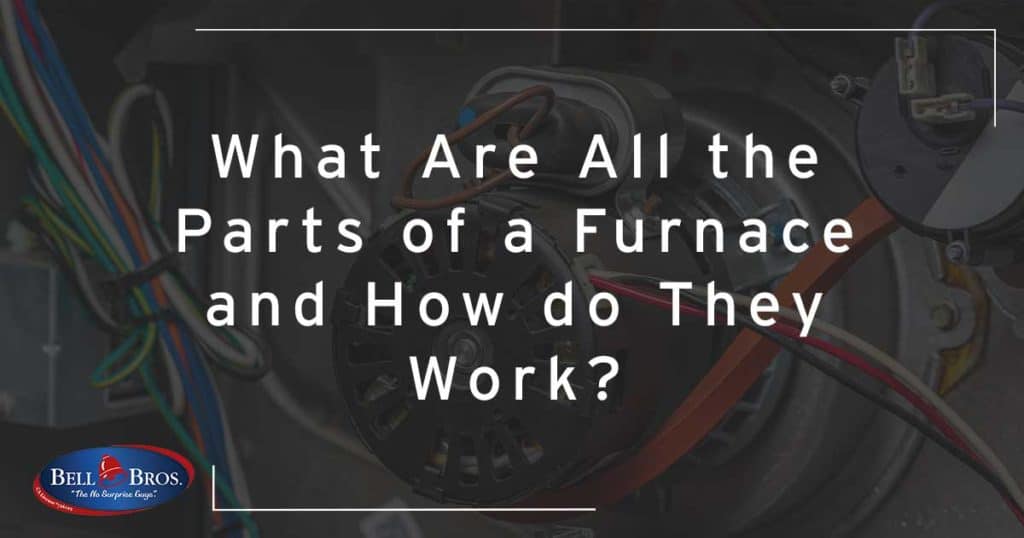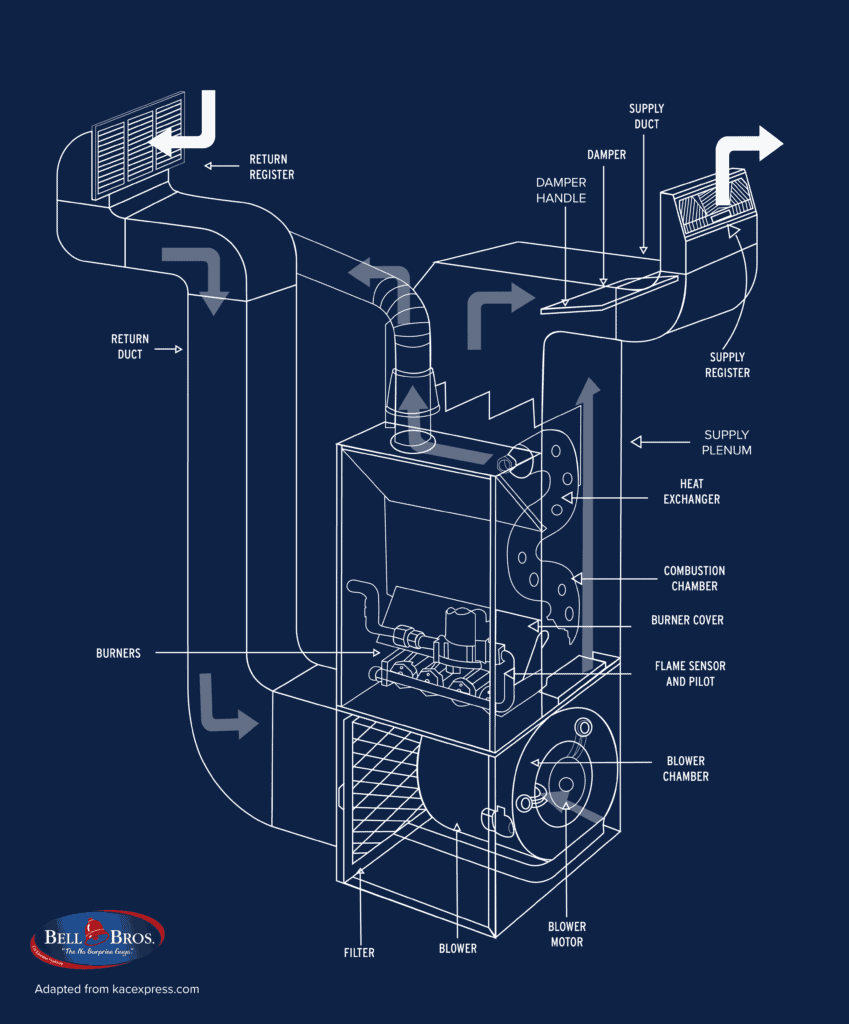What Are All the Parts of a Furnace and How do They Work?
 For most of our Sacramento and East Bay homeowners, the furnace is just a system that keeps working until it doesn’t. There’s actually a lot more going on in that metal box than one would think. That’s why we put together this handy guide answering the questions what are the parts of a furnace and how do they work?
For most of our Sacramento and East Bay homeowners, the furnace is just a system that keeps working until it doesn’t. There’s actually a lot more going on in that metal box than one would think. That’s why we put together this handy guide answering the questions what are the parts of a furnace and how do they work?
Parts of a Furnace and How they Work
- Return Register
- If your home has a central air system, it has return and supply vents. The return vents pull air from within your home and “return” that air to your HVAC system. These vents are normally found on your ceiling, most typically a hallway. When you turn on the heat, the return register is the first thing that kicks into gear. It’s also the first thing our technicians check during a tune-up.
- Return Duct
- When the air is sucked into the return duct, it has to go somewhere, right? That’s why your system is equipped with a return duct. It takes the cold or ambient air and directs it to your furnace.
- Air Filter
- The air filter is a critical part of your HVAC system. It protects your home, family, and HVAC system itself form polluted or contaminated air. After air is pulled in through the return vent and through the duct, it then passes through the air filter. The filter will trap indoor air contaminates and stop them from going back into your home.
- Blower
- The blower lives up to its name. It basically sucks air from the return and blows it further into the furnace. The blower propels air all the way through the furnace and into the return ducts. The blower is so important because air can be sucked in, but where would it go without a little push?
- Blower Motor
- The blower itself is a big fan and in the middle is the blower motor. The blower motor powers the fan and makes sure everything is in constant rotation.
- Blower Chamber
- The blower and blower motor need a home. The blower chamber is where the blower and blower motor are housed. It’s a metal box that makes sure everything is stabilized and moving properly.
- Burners
- We all know you were wondering when we would get to the flame component of the system. The burners are where the flames come from. They pull natural gas from a public gas line, distribute it into the combustion chamber, then the pilot light or electric ignition sets the whole thing ablaze.
- Flame Sensor
- Though the flame sensor is a small device, it has a big job to do. The flame sensor is a small bar that sticks out into the combustion chamber. It regulates how much heat the burners are generating. If the burners are doing their job correctly, the flame sensor will just essentially do nothing. If the burners are not emitting enough heat, or there is a lot of gas and no fire, the flam sensor will shut down your HVAC system. Without the flame sensor, carbon monoxide could come trickling into your home.
- Pilot Light or Electronic Ignition
- Pilot lights and electronic ignitions perform the same function. Older systems have a pilot light and newer systems—ones made within the last 10 years—will have an electronic ignition.
Pilot lights pose a problem because they are always running. The theory is that if the light is always on and there’s a little flame, then you can create heat at a moment’s notice. Despite this, there are a few issues with the old pilot light system. One is that the pilot light uses gas. Meaning there is always a small gas flow in your system. The other problem is that sometimes the pilot light goes out. Whether it’s a draft of wind or something large falling over and creating friction, it’s very easy for the light to go out.
The electronic ignition is the solution to the pilot light. They both do the same job, but in different ways. On modern devices, a thermostat sends a signal to the electronic ignition and that sends a spark to the burners.
- Pilot lights and electronic ignitions perform the same function. Older systems have a pilot light and newer systems—ones made within the last 10 years—will have an electronic ignition.
- Burner Cover
- We can all agree that a flame is something that should be contained, right? That’s why furnaces have a burner cover. It sits over the burners, flame sensor, blower chamber, and electronic ignition or pilot light and keeps everything in place.
- Combustion Chamber
- All of these pieces live in a chamber, and that’s the combustion chamber. It holds the burners, flame sensor, flames, and pilot light or electric ignition in one place and makes sure the fire stays in one place. The combustion chamber is separate from the blower chamber for safety reasons.
- Heat Exchanger
- While the combustion chamber is where the flame is made, the heat exchanger makes warm, treated air. Natural gasses and fire start the combustion process. This mix of chemicals create what we call “combustion gasses.” These gasses can be harmful to human health.
Combustion gasses are created then pushed into the heat exchanger. They warm the outer walls of the heat exchanger. As the walls of the heat exchanger are being warmed up, treated air is pushed over the heat exchanger. This treated air then gets its warmth from the hot walls of the heat exchanger.
After the heat is transferred to the filtered air and that air is pushed into the home, the heat exchanger pushes the combustion gasses through the flu pipe and out of your home.
- While the combustion chamber is where the flame is made, the heat exchanger makes warm, treated air. Natural gasses and fire start the combustion process. This mix of chemicals create what we call “combustion gasses.” These gasses can be harmful to human health.
- Supply Plenum
- Now that the air is treated and warm, it’s time for it to go into your home! But, it can’t go all at once. The supply plenum receives heat treated air from the heat exchanger and prepares to send that all back into your home.
- Damper
- The supply plenum is the holding space and the damper acts as air traffic control. It regulates how much air goes where in your home. If your home is zoned or you have the option of “low air,” the damper will determine how much air to distribute where.
- Supply Duct
- For every return duct there’s a supply duct. While the returns bring air back into the HVAC system, the supply ducts send treated air into your home.
- Supply Register
- And the final step of the process is the supply register. Supply registers are usually found at your baseboards and distribute treated air through the house.
Make Sure Your Furnace is Ready for Anything with Bell Brothers
We will always say it, the best thing you can do for your HVAC system is to schedule twice yearly maintenance. Once in the spring for the AC season and once in the fall for the furnace season. During a tune-up, one of our expert HVAC technicians will make sure to check 18 points of your furnace. From aesthetics to safety, we go over everything and provide you with a full report.
Still Need to Schedule Your Tune-Up?
It’s never too early or too late in the season to make sure your HVAC system is in tip-top shape. The techs are Bell Brothers stand out from the rest and it’s easy to see why. From our stellar reviews to the exceptional training, we provide every year, they are truly the best. If you’re in Sacramento, Stockton, Vacaville, or the East Bay, call the number at the top of the screen or click here to request an appointment online.

